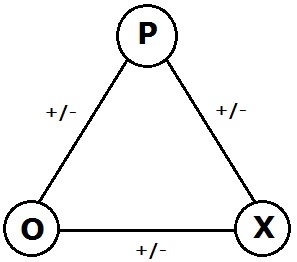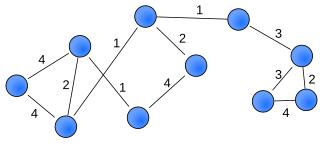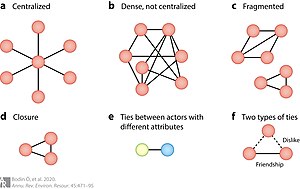In computer science, an integer is a datum of integral data type, a data type that represents some range of mathematical integers. Integral data types may be of different sizes and may or may not be allowed to contain negative values. Integers are commonly represented in a computer as a group of binary digits (bits). The size of the grouping varies so the set of integer sizes available varies between different types of computers. Computer hardware nearly always provides a way to represent a processor register or memory address as an integer.

Dijkstra's algorithm is an algorithm for finding the shortest paths between nodes in a weighted graph, which may represent, for example, road networks. It was conceived by computer scientist Edsger W. Dijkstra in 1956 and published three years later.

Social network analysis (SNA) is the process of investigating social structures through the use of networks and graph theory. It characterizes networked structures in terms of nodes and the ties, edges, or links that connect them. Examples of social structures commonly visualized through social network analysis include social media networks, meme spread, information circulation, friendship and acquaintance networks, peer learner networks, business networks, knowledge networks, difficult working relationships, collaboration graphs, kinship, disease transmission, and sexual relationships. These networks are often visualized through sociograms in which nodes are represented as points and ties are represented as lines. These visualizations provide a means of qualitatively assessing networks by varying the visual representation of their nodes and edges to reflect attributes of interest.

Sinus node dysfunction (SND), also known as sick sinus syndrome (SSS), is a group of abnormal heart rhythms (arrhythmias) usually caused by a malfunction of the sinus node, the heart's primary pacemaker. Tachycardia-bradycardia syndrome is a variant of sick sinus syndrome in which the arrhythmia alternates between fast and slow heart rates.

In mathematics, computer science and network science, network theory is a part of graph theory. It defines networks as graphs where the nodes or edges possess attributes. Network theory analyses these networks over the symmetric relations or asymmetric relations between their (discrete) components.

In the area of graph theory in mathematics, a signed graph is a graph in which each edge has a positive or negative sign.

A computer network is a set of computers sharing resources located on or provided by network nodes. Computers use common communication protocols over digital interconnections to communicate with each other. These interconnections are made up of telecommunication network technologies based on physically wired, optical, and wireless radio-frequency methods that may be arranged in a variety of network topologies.

RDFLib is a Python library for working with RDF, a simple yet powerful language for representing information. This library contains parsers/serializers for almost all of the known RDF serializations, such as RDF/XML, Turtle, N-Triples, & JSON-LD, many of which are now supported in their updated form. The library also contains both in-memory and persistent Graph back-ends for storing RDF information and numerous convenience functions for declaring graph namespaces, lodging SPARQL queries and so on. It is in continuous development with the most recent stable release, rdflib 6.1.1 having been released on 20 December 2021. It was originally created by Daniel Krech with the first release in November, 2002.

In social network analysis and mathematical sociology, interpersonal ties are defined as information-carrying connections between people. Interpersonal ties, generally, come in three varieties: strong, weak or absent. Weak social ties, it is argued, are responsible for the majority of the embeddedness and structure of social networks in society as well as the transmission of information through these networks. Specifically, more novel information flows to individuals through weak rather than strong ties. Because our close friends tend to move in the same circles that we do, the information they receive overlaps considerably with what we already know. Acquaintances, by contrast, know people that we do not, and thus receive more novel information.
Internal migration or domestic migration is human migration within a country. Internal migration tends to be travel for education and for economic improvement or because of a natural disaster or civil disturbance, though a study based on the full formal economy of the United States found that the median post-move rise in income was only 1%.

A weighted network is a network where the ties among nodes have weights assigned to them. A network is a system whose elements are somehow connected. The elements of a system are represented as nodes and the connections among interacting elements are known as ties, edges, arcs, or links. The nodes might be neurons, individuals, groups, organisations, airports, or even countries, whereas ties can take the form of friendship, communication, collaboration, alliance, flow, or trade, to name a few.
The clique percolation method is a popular approach for analyzing the overlapping community structure of networks. The term network community has no widely accepted unique definition and it is usually defined as a group of nodes that are more densely connected to each other than to other nodes in the network. There are numerous alternative methods for detecting communities in networks, for example, the Girvan–Newman algorithm, hierarchical clustering and modularity maximization.
In astronomy, the color index is a simple numerical expression that determines the color of an object, which in the case of a star gives its temperature. The lower the color index, the more blue the object is. Conversely, the larger the color index, the more red the object is. This is a consequence of the logarithmic magnitude scale, in which brighter objects have smaller magnitudes than dimmer ones. For comparison, the whitish Sun has a B−V index of 0.656 ± 0.005, whereas the bluish Rigel has a B−V of −0.03. Traditionally, the color index uses Vega as a zero point.
Bipartite network projection is an extensively used method for compressing information about bipartite networks. Since the one-mode projection is always less informative than the original bipartite graph, an appropriate method for weighting network connections is often required. Optimal weighting methods reflect the nature of the specific network, conform to the designer's objectives and aim at minimizing information loss.

In machine learning, feature learning or representation learning is a set of techniques that allows a system to automatically discover the representations needed for feature detection or classification from raw data. This replaces manual feature engineering and allows a machine to both learn the features and use them to perform a specific task.
Weighted correlation network analysis, also known as weighted gene co-expression network analysis (WGCNA), is a widely used data mining method especially for studying biological networks based on pairwise correlations between variables. While it can be applied to most high-dimensional data sets, it has been most widely used in genomic applications. It allows one to define modules (clusters), intramodular hubs, and network nodes with regard to module membership, to study the relationships between co-expression modules, and to compare the network topology of different networks. WGCNA can be used as a data reduction technique, as a clustering method, as a feature selection method, as a framework for integrating complementary (genomic) data, and as a data exploratory technique. Although WGCNA incorporates traditional data exploratory techniques, its intuitive network language and analysis framework transcend any standard analysis technique. Since it uses network methodology and is well suited for integrating complementary genomic data sets, it can be interpreted as systems biologic or systems genetic data analysis method. By selecting intramodular hubs in consensus modules, WGCNA also gives rise to network based meta analysis techniques.

Disparity filter is a network reduction algorithm to extract the backbone structure of undirected weighted network. Many real world networks such as citation networks, food web, airport networks display heavy tailed statistical distribution of nodes' weight and strength. Disparity filter can sufficiently reduce the network without destroying the multi-scale nature of the network. The algorithm is developed by M. Angeles Serrano, Marian Boguna and Alessandro Vespignani.

In network science, a biased random walk on a graph is a time path process in which an evolving variable jumps from its current state to one of various potential new states; unlike in a pure random walk, the probabilities of the potential new states are unequal.
Structural holes is a concept from social network research, originally developed by Ronald Stuart Burt. A structural hole is understood as a gap between two individuals who have complementary sources to information. The study of structural holes spans the fields of sociology, economics, and computer science. Burt introduced this concept in an attempt to explain the origin of differences in social capital. Burt’s theory suggests that individuals hold certain positional advantages/disadvantages from how they are embedded in neighborhoods or other social structures.

Blockmodeling is a set or a coherent framework, that is used for analyzing social structure and also for setting procedure(s) for partitioning (clustering) social network's units, based on specific patterns, which form a distinctive structure through interconnectivity. It is primarily used in statistics, machine learning and network science.









